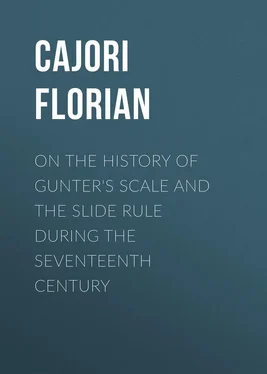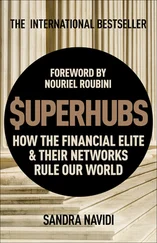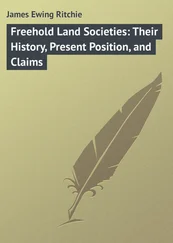Florian Cajori - On the History of Gunter's Scale and the Slide Rule during the Seventeenth Century
Здесь есть возможность читать онлайн «Florian Cajori - On the History of Gunter's Scale and the Slide Rule during the Seventeenth Century» — ознакомительный отрывок электронной книги совершенно бесплатно, а после прочтения отрывка купить полную версию. В некоторых случаях можно слушать аудио, скачать через торрент в формате fb2 и присутствует краткое содержание. ISBN: , Издательство: Иностранный паблик, Жанр: foreign_antique, foreign_prose, на английском языке. Описание произведения, (предисловие) а так же отзывы посетителей доступны на портале библиотеки ЛибКат.
- Название:On the History of Gunter's Scale and the Slide Rule during the Seventeenth Century
- Автор:
- Издательство:Иностранный паблик
- Жанр:
- Год:неизвестен
- ISBN:http://www.gutenberg.org/ebooks/42216
- Рейтинг книги:4 / 5. Голосов: 1
-
Избранное:Добавить в избранное
- Отзывы:
-
Ваша оценка:
- 80
- 1
- 2
- 3
- 4
- 5
On the History of Gunter's Scale and the Slide Rule during the Seventeenth Century: краткое содержание, описание и аннотация
Предлагаем к чтению аннотацию, описание, краткое содержание или предисловие (зависит от того, что написал сам автор книги «On the History of Gunter's Scale and the Slide Rule during the Seventeenth Century»). Если вы не нашли необходимую информацию о книге — напишите в комментариях, мы постараемся отыскать её.
On the History of Gunter's Scale and the Slide Rule during the Seventeenth Century — читать онлайн ознакомительный отрывок
Ниже представлен текст книги, разбитый по страницам. Система сохранения места последней прочитанной страницы, позволяет с удобством читать онлайн бесплатно книгу «On the History of Gunter's Scale and the Slide Rule during the Seventeenth Century», без необходимости каждый раз заново искать на чём Вы остановились. Поставьте закладку, и сможете в любой момент перейти на страницу, на которой закончили чтение.
Интервал:
Закладка:
This Mr. Milburn is probably the person named in the diary of the antiquarian, Elias Ashmole, on August 13 [1646?]; “I bought of Mr. Milbourn all his Books and Mathematical Instruments.” 8 8 Memories of the Life of that Learned Antiquary, Elias Ashmole, Esq.; Drawn up by himself by way of Diary. With Appendix of original Letters. Publish’d by Charles Burman, Esq., London, 1717, p. 23.
Charles Hutton 9 9 Mathematical Tables , 1811, p. 36, and art. “Gunter’s Line” in his Phil. and Math. Dictionary , London, 1815.
says that Milburne of Yorkshire designed the spiral form about 1650. This date is doubtless wrong, for Thomas Browne who, according to Leybourn, got the spiral form of line from Milbourn, is repeatedly mentioned by William Oughtred in his Epistle 10 10 To the English Gentrie, and all others studious of the Mathematicks, which shall bee readers hereof. The just Apologie of Wil: Ovghtred, against the slaunderous insimulations of Richard Delamain, in a Pamphlet called Grammelogia, or the Mathematicall Ring, or Mirifica logarithmorum projectio circularis. We shall refer to this document as Epistle . It was published without date in 32 unnumbered pages of fine print, and was bound in with Oughtred’s Circles of Proportion , in the editions of 1633 and 1639. In the 1633 edition it is inserted at the end of the volume just after the Addition vnto the Vse of the Instrument etc. , and in that of 1639 immediately after the preface. It was omitted from the Oxford edition of 1660. The Epistle was also published separately. There is a separate copy in the British Museum, London. Aubrey, in his Brief Lives , edited by A. Clark, Vol. II, Oxford, 1898, p. 113, says quaintly, “He writt a stitch’t pamphlet about 163(?4) against.. Delamaine.”
printed some time in 1632 or 1633. Oughtred does not mention Milbourn, and says (page 4) that the spiral form “was first hit upon by one Thomas Browne a Joyner… the serpentine revolution being but two true semicircles described on severall centers.” 11 11 Thomas Browne is mentioned by Stone in his Mathematical Instruments , London 1723, p. 16. See also Cajori, History of the Slide Rule , New York, 1909, p. 15.
Thomas Brown did not publish any description of his instrument, but his son, John Brown, published in 1661 a small book, 12 12 The Description and Use of a Joynt-Rule:.. also the use of Mr. White’s Rule for measuring of Board and Timber, round and square; With the manner of Vsing the Serpentine-line of Numbers, Sines, Tangents, and Versed Sines. By J. Brown, Philom., London, 1661.
in which he says (preface) that he had done “as Mr. Oughtred with Gunter’s Rule, to a sliding and circular form; and as my father Thomas Brown into a Serpentine form; or as Mr. Windgate in his Rule of Proportion .” He says also that “this brief touch of the Serpentine-line I made bold to assert, to see if I could draw out a performance of that promise, that hath been so long unperformed by the promisers thereof.” Accordingly in Chapter XX he gives a description of the serpentine line, “contrived in five (or rather 15) turn.” Whether this description, printed in 1661, exactly fits the instrument as it was developed in 1632, we have no means of knowing. John Brown says:
1. First next the center is two circles divided one into 60, the other into 100 parts, for the reducing of minutes to 100 parts, and the contrary.
2. You have in seven turnes two inpricks, and five in divisions, the first Radius of the sines (or Tangents being neer the matter, alike to the first three degrees,) ending at 5 degrees and 44 minutes.
3. Thirdly, you have in 5 turns the lines of numbers, sines, Tangents, in three margents in divisions, and the line of versed sines in pricks, under the line of Tangents, according to Mr. Gunter’s cross-staff: the sines and Tangents beginning at 5 degrees, and 44 minutes where the other ended, and proceeding to 90 in the sines, and 45 in the Tangents. And the line of numbers beginning at 10, and proceeding to 100, being one entire Radius, and graduated into as many divisions as the largeness of the instrument will admit, being 10 to 10 50 into 50 parts, and from 50 to 100 into 20 parts in one unit of increase, but the Tangents are divided into single minutes from the beginning to the end, both in the first, second and third Radiusses, and the sines into minutes; also from 30 minutes to 40 degrees, and from 40 to 60, into every two minutes, and from 60 to 80 in every 5th minute, and from 80 to 85 every 10th, and the rest as many as can be well discovered.
The versed sines are set after the manner of Mr. Gunter’s Cross-staff, and divided into every 10th minutes beginning at 0, and proceeding to 156 going backwards under the line of Tangents.
4. Fourthly, beyond the Tangent of 45 in one single line, for one Turn is the secants to 51 degrees, being nothing else but the sines reitterated beyond 90.
5. Fifthly, you have the line of Tangents beyond 45, in 5 turnes to 85 degrees, whereby all trouble of backward working is avoided.
6. Sixthly, you have in one circle the 180 degrees of a Semicircle, and also a line of natural sines, for finding of differences in sines, for finding hour and Azimuth.
7. Seventhly, next the verge or outermost edge is a line of equal parts to get the Logarithm of any number, or the Logarithm sine and Tangent of any ark or angle to four figures besides the carracteristick.
8. Eightly and lastly, in the space place between the ending of the middle five turnes, and one half of the circle are three prickt lines fitted for reduction. The uppermost being for shillings, pence and farthings. The next for pounds, and ounces, and quarters of small Averdupoies weight. The last for pounds, shillings and pence, and to be used thus: If you would reduce 16s. 3d. 2q. to a decimal fraction, lay the hair or edge of one of the legs of the index on 16. 3½ in the line of 1. s. d. and the hair shall cut on the equal parts 81 16; and the contrary, if you have a decimal fraction, and would reduce it to a proper fraction, the like may you do for shillings, and pence, and pounds, and ounces.
As to the use of these lines, I shall in this place say but little, and that for two reasons. First, because this instrument is so contrived, that the use is sooner learned then any other, I speak as to the manner, and way of using it, because by means of first second and third radiusses, in sines and Tangents, the work is always right on, one way or other, according to the Canon whatsoever it be, in any book that treats of the Logarithms, as Gunter , Wells , Oughtred , Norwood , or others, as in Oughtred from page 64 to 107.
Secondly, and more especially, because the more accurate, and large handling thereof is more then promised, if not already performed by more abler pens, and a large manuscript thereof by my Sires meanes, provided many years ago, though to this day not extant in print; so for his sake I claiming my interest therein, make bold to present you with these few lines, in order to the use of them: And first note,
1. Which soever of the two legs is set to the first term in the question, that I call the first leg always, and the other being set to the second term, I call the second leg.
The exact nature of the contrivance with the “two legs” is not described, but it was probably a flat pair of compasses, attached to the metallic surface on which the serpentine line was drawn. In that case the instrument was a slide rule, rather than a form of Gunter’s line. In his publication of 1661, as also in later publications, 13 13 A Collection of Centers and Useful Proportions on the Line of Numbers , by John Brown, 1662(?), 16 pages; Description and Use of the Triangular Quadrant , by John Brown, London, 1671; Wingate’s Rule of Proportion in Arithmetick and Geometry: or Gunter’s Line . Newly rectified by Mr. Brown and Mr. Atkinson, Teachers of the Mathematicks , London, 1683; The Description and Use of the Carpenter’s-Rule: Together with the Use of the Line of Numbers commonly call’d Gunter’s-Line , by John Brown, London, 1704.
John Brown devoted more space to Gunter’s scales, requiring the use of a separate pair of compasses, than to slide rules.
Интервал:
Закладка:
Похожие книги на «On the History of Gunter's Scale and the Slide Rule during the Seventeenth Century»
Представляем Вашему вниманию похожие книги на «On the History of Gunter's Scale and the Slide Rule during the Seventeenth Century» списком для выбора. Мы отобрали схожую по названию и смыслу литературу в надежде предоставить читателям больше вариантов отыскать новые, интересные, ещё непрочитанные произведения.
Обсуждение, отзывы о книге «On the History of Gunter's Scale and the Slide Rule during the Seventeenth Century» и просто собственные мнения читателей. Оставьте ваши комментарии, напишите, что Вы думаете о произведении, его смысле или главных героях. Укажите что конкретно понравилось, а что нет, и почему Вы так считаете.












